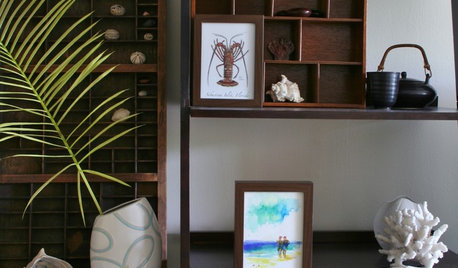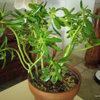anthurium in water
Dear all,
A friend gave me a anthurium plant with tiny red flowers in a vulcanic rock from Hawaii. It came immersed in water. I have the plant for one year; it never bloosomed again and the leaves are barely surviving...
At first, I kept the rock immersed in water. Now, water covers only 1-2 milimeters, just enough to keep the bottom of the rock wet.
Any insights appreciated.
Thanks!
Comments (15)
alisonoz_gw
17 years agoOh dear, too much water, I think.
Perhaps the delivery method was just to ensure it wouldn't dry out at the time. Anthuriums are not water plants, though they like moisture they need good drainage not wet feet. And after a year, sitting in water, perhaps no nutrients left, or a build-up of salts.
I'm not sure where you are but if there is enough warmth to keep the thing growing I would certainly consider potting it into a suitable medium and giving your volcanoc rock to a bonsai enthusuast. Good luck and if you do a "google" search on, say, "Anthurium drainage" you should find plenty of articles to help. Here's one linkHere is a link that might be useful: a link
bihai
17 years agoMany anthuriums in nature are epiphytic and lithophytic, they grow in the rainforest canopy clinging to the branches of trees and onto cliffsides where water drips down. But they don't live ***in***water. You can grow an anthurium mounted to lava rock/volcanic stone easily, but you musttreat it like a mounted orchid: good light, good air circulation, warmth, humidity, mist it daily, and once a week or maybe once every two weeks, add some fertilizer to the water you mist with. An orchid fertilizer would be fine. Follow the dilution directions on the box. Anthuriums that are potted in media or planted into the ground will still eventually push roots up through the soil to try to attain their epiphytic nature. If you do pot your anthurium, use a mix of well draining highly organic mix, liberally peppered with bagged wood chips, perlite, even small pieces of bagged lava rock or aliflor.
Related Professionals
Beavercreek Landscape Architects & Landscape Designers · Essex Landscape Architects & Landscape Designers · Kapaa Landscape Architects & Landscape Designers · Peabody Landscape Contractors · Surprise Landscape Contractors · Flagstaff Landscape Contractors · Garland Landscape Contractors · Hoover Landscape Contractors · Inglewood Landscape Contractors · La Vista Landscape Contractors · New Berlin Landscape Contractors · North Potomac Landscape Contractors · Oxnard Landscape Contractors · Vashon Landscape Contractors · Palos Heights Landscape Contractorschinadollfree
Original Author17 years agoIt is strange that the plant came immersed in water.
I will get the proper soil and fertilizer. Thanks for the information and links.
birdsnblooms
17 years agoChinadoll, for one thing, you can set the planter on pebbles fill w/water. Don't allow water to hit roots if your pot has drainage holes.
Do you fertilize? If so, alternate all purpose food one month and blooming food the next.
Feeding should be done during growing season, so if your anthurium has gone dormant withhold feeding. Tonichinadollfree
Original Author17 years agoHi Hopefulauthor,
I liked the idea of using pebbles because the vase looks more beautiful. I got both kinds of fertilizers.
I have a layperson's question: If the roots can not hit the water, how is the plant going to get the minerals? The plant is in a rock; the roots are on top of the rock.
Thanks again
heleninseattle
17 years agoI have an anthurium growing on a lava rock sitting right here on my desk. I purchased it a year ago at the flower show. The rock is in a shallow bowl that always has just a little water. Lava rock is porous and the plant sucks the water up through the rock. The roots, themselves, are not in the water. I occasionally put a couple drops of liquid plant food in the water and my plant continually flowers and seems quite happy.
Steve_ExoticRainforest_com
16 years agoThis link may help you better understan how Anthurium species grow in nature:
http://www.exoticrainforest.com/Grow%20or%20Growing%20Anthurium%20species.html
There is no Anthurium known to science that grows in water according to Dr. Tom Croat of the Missouri Botanical Garden. Dr. Croat is the world's leading authority on Anthurium species.
Here is a link that might be useful: Growing Anthurium species
exoticrainforest
16 years agoJust a follow-up if I may.
About one year ago there was some discussion regarding the way Dr. Darian grows his Anthurium regale seeds. One seller made it appear in their ads Mardy was growing them in water. I questioned that approach. I was "scolded" for even questioning how Mardy grew his plants since I suggested at that time growing Anthurium species in water was not wise as a result of conversations with top aroid botanist Dr. Tom Croat. I then called Dr. Darian and we have since had at least four conversations regarding his technique. Mardy has initiated at least two of those conversations.
Dr. Darian does not actually grow his juvenile Anthurium regale "in water". He places the seeds and starts in sphagnum moss in what is effectively a pot. Those are then placed in a shallow pan of water (about 1 inch) and the moss used as a wick. The effect is the moss draws water up to the plant/seed. The plant is not growing sitting in water.
Dr. Darian has had great success growing with this technique. But if you speak with him directly you'll learn he is attempting to create a micro-climate that replicates a tropical environment in the dry southern California region where he lives. In fact, he has been very successful creating such micro-climates all over his property.
We have also had great success growing Anthurium species including an Anthurium regale which has repeatedly produced very large leaves and is currently in the process of producing a second spathe and spadix. Our collection contains over 70 Anthurium species, many rare and some quite large. If you'd like to read our personal research on this species which was done with the help and guidance of Dr. Tom Croat of the Missouri Botanical Garden, LariAnn Garner of Aroidea Research and Julius Boos who is one of the country's most knowledgeable aroid experts, you can read about what we've learned together at this link.
LariAnn was of great help to us and recently posted on this board in a separate link a note saying she had changed her own technique in growing Anthurium regale plants which came from Dr. Darian as a result of what we all learned together. If you contact LariAnn I'm certain she will tell you she does not grow them in water. There are several pages which track the entire progress of Anthurium regale producing a spathe and spadix.
If you're serious about growing Anthurium species, you may find these pages useful.
Here is a link that might be useful: Growing Anthurium regale
edleigh7
16 years agoG'day Steve...you can't hide anywhere lol!! Thats very interesting about Anthuriums being epiphytes. My two are in the ground and look like they are doing fine. So therefore I should be able to start off seedlings as an epiphyte, correct??
Ed
Steve_ExoticRainforest_com
16 years agoCorrect. The majority of Anthurium species do not grow naturally in the soil. But almost all WILL grow in soil. As epiphytes, once they begin to drop roots down from the tree branch, eventually some, possibly many, of those roots will eventually reach the soil.
When that happens the plant will experience a growth spurt due to the extra nutrients and water the roots can not gather from the porous soil and the nutrients created by decaying vegetation. The plant will often grow much larger once that happens.
So, if you have an Anthurium species in soil and would like to grow it as an epiphyte, that is possible. But you must make the transfer cautiously. I now grow many of my Anthurium species in hanging wooden orchid baskets. I leave the soil that is attached to the roots in place but wrap the plant in a relatively loose blanket of very wet sphagnum moss. Do not pack it tight. That moss "ball" is then placed in a wooden orchid basket and the remainder of the basket filled with sphagnum. It is very important you never allow that moss to dry completely.
During the summer, I water daily. Within a few months you will begin to see epiphytic roots begin to hang from the basket. I now have some specimens with roots 3 feet long, some more, hanging out the bottom of the wooden basket. Eventually, the roots will attach themselves to the wood and you now have an epiphytic specimen. Again.
edleigh7
16 years agoI know what you mean about transfer cautiously. I tried with an Asplenium nidus (birdsnest fern) but it died. My anthurium is fairly large and I wouldn't risk. Will post on other for ID later. Thanks for that
Ed
jennifer1
16 years agoI own a houseplant store and I sell anthuriums. One of my customers told me a couple weeks ago that she has an anthurium in a vase of water and she has had it many years. I had one anthurium that wasn't doing to well so I thought I would experiment. I put it in a vase of water making sure only the roots were in water. It has been a couple of weeks now and it looks great!
Steve_ExoticRainforest_com
16 years agoJennifer, Dr. Croat has told me repeatedly "anything is possible". But just because it works for a while doesn't mean it is the best for the plant. Something tells me if nature had intended Anthurium species to grow in water there would be at least one species out there that does. According to Dr. Croat, who is recognized as the world authority on these species, there is none. You may succeed. But my question would be, would the plant grow larger and be more healthy in soil? Or as an epiphyte? Sometimes people try new things and succeed. That does not mean it is the best for the plant. I often use the motto "Listen to Mother Nature, her advice is best". Her advice appears to be Anthurium species just don't grow in water. I hope your plant continues to prosper but I've got a suspicion the day will come you'll put it back in soil. I've traded mail with people all over the world who have tried this and almost all have come back later saying they put the plant back in soil once it began to decline. Ask LariAnn Garner. Her advice on this board is considered gold! I think you'll find she agrees with me.










DelWH